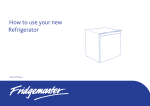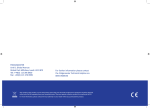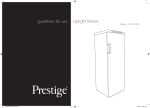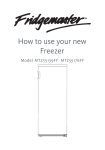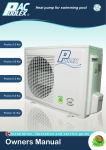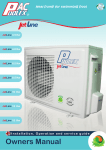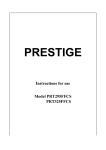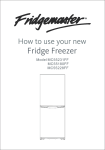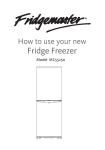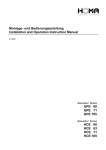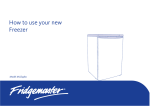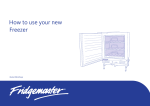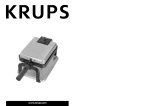Download Hisense MTTZ4430 freezer
Transcript
How to use your new Freezer Model MTTZ4430 3 SAFETY Safety and warning information Important information when using the appliance Before you switch ON the appliance • This appliance is not intended for use by persons (including children) with reduced physical, sensory or mental capabilities, or experience or knowledge, unless they have been given supervision or instructions concerning the use of the appliance by a person responsible for their safety. Children should be supervised to ensure that they do not play with the appliance. • If the supply cord is damaged, it must be replaced by the manufacturer, its service agent or similarly qualified persons in order to avoid a hazard. • Never use electrical appliances inside the refrigerator (e.g. heater, electric ice maker, etc.). Explosion hazard! • Never use a steam cleaner to clean the appliance. The steam may penetrate electrical parts and cause a short circuit. Risk of electric shock! • Do not store products which contain flammable propellants (e.g. spray cans) or explosive substances in the appliances. Explosion hazard! • Do not stand or support yourself on the base, drawers or doors, etc. • Before defrosting and cleaning the appliance, pull out the mains plug or switch off the fuse. Do not pull out the mains plug by tugging the cable. • Commercially frozen pre-packed food should be stored in accordance with the frozen food manufacturers instruction. • Bottles containing a high percentage of alcohol must be sealed and stored in an upright position. • Keep plastic parts and the door seal free of oil and grease. Otherwise, the plastic and door seal will become porous. • Never cover or block the ventilation openings for the appliance. • Do not store bottled or canned drinks (especially carbonated drinks) in the ice compartment. Bottles and cans may explode! • Never put frozen food, or ice cubes, straight from the ice compartment into your mouth. Risk of frost burns to the lips and tongue! • Avoid prolonged touching of frozen food, ice or the inner freezer walls or tubing etc. Risk of frost burns to the skin. • Do not scrape off frost or stuck frozen food with a knife or pointed object. You could damage the refrigerant tubing. Leaking refrigerant may ignite. Only use a plastic scraper. • In the case of malfunction, under no circumstances should you attempt to repair the appliance yourself. Repairs carried out by inexperienced persons may cause injury or further malfunctioning to the appliance. • When the appliance is unplugged please wait for 5 minutes before plugging it in again. Otherwise, the compressor will be overloaded. Please read the operating and installation instructions carefully. They contain important information on how to install, use and maintain the appliance. Keep all documentation for subsequent use or for the next owner. Technical safety This appliance contains a small quantity of environmentally friendly but flammable R600a refrigerant. Ensure that the tubing of the refrigeration circuit is not damaged during transportation and installation. Leaking refrigerant may ignite. If damage has occurred - Keep naked flames and/or ignition sources away from the appliance. - Pull out the mains plug. - Thoroughly ventilate the room for several minutes. - Notify customer services. The more refrigerant an appliance contains, the larger the room must be. Leaking refrigerant can form a flammable gas-air mixture in rooms which are too small. The room must be at least 1m3 per 8 g of refrigerant. The amount of refrigerant in your appliance is indicated on the rating label on your appliance. • Do not use electrical appliances such as a hairdryer or heaters near your refrigerator. • Do not store inflammable gases or liquids inside your refrigerator. Children in the household • Keep children away from the packaging and its parts. Danger of suffocation from folding cardboard and plastic film! • Do not allow children to tamper with the controls or play with the appliance. It is not a toy. Under no circumstances should children be allowed to sit on the bins or hang from the door. • If the appliance features a lock, keep the key out of the reach of children. General requirements • The appliance is designed for domestic use inside the home and is not intended for commercial or industrial use. • The appliance must be used to store food products by adults only and according to the instruction manual. • Try to avoid keeping the door open for long periods or opening the door too frequently in order to conserve energy. • Do not fill the appliance with too much food: cold air must circulate freely for food to be preserved properly. 4 GETTING TO KNOW YOUR FREEZER INSTALLATION Location Before use Please read these instructions carefully before using your new Fr idgemaster Freezer. The Freezer is for indoor, domestic use only. Please keep this instruction manual in a safe place for future reference. THERMOSTAT (Back bottom Corner) CONTROL DIAL When selecting a postion to place your Freezer you should make sure that the surface is flat and firm, and the room is dry and well vetilated with an average room temperature of between 16ºC and 38ºC. Avoid locating your Freezer near a heat source, e.g. cooker, boiler or radiator. Also avoid direct sunlight. When your Freezer is working, the side panels may become hot and so to allow adequate ventilation there must be a space of at least 10cm between the sides and 7.5cm from the back of the Freezer and any adjacent wall or cupboard. A space of at least 10 cm must be left between the top of the Freezer and any cupboard, work surface or low ceiling above it. Do not drape the Freezer with any covering . Levelling the Freezer Remove the packaging support from the Freezer. Check that the Freezer is placed on a level and stable surface. To make sure the Freezer is level adjust the Levelling Foot at the front. If the Freezer is not level, the doors and magnetic seal alignments will be affected. Cleaning before use REMOVABLE SHELF Wipe the inside of the Freezer with a weak solution of bicarbonate of soda. Then rinse with warm water using a ‘wrung-out’ sponge or cloth. Wipe completely dry before replacing the baskets. You could clean the Freezer externally with wax polish. If you require more information refer to DEFROSTING & CLEANING the Freezer on page 8. Before plugging in YOU MUST Check that you have a socket which is compatible with the plug supplied with the Freezer. If not, see the section called ELECTRICAL CONNECTIONS on page 10. Before switching on! DO NOT SWITCH ON UNTIL TWO HOURS AFTER MOVING THE FREEZER. The coolant fluid needs time to settle. ADJUSTABLE FOOT Before using your Freezer Before placing frozen foods in your Freezer, switch on the Freezer and wait for 24 hours, to make sure it is working properly and to allow the Freezer to fall to the correct temperature. Your Freezer should not be overfilled. ICE CUBE TRAY 5 USING YOUR FREEZER Switching on your Freezer 1 Before connecting the Freezer to the mains supply make sure that the Thermostat Control Dial, located at 1 the rear the Freezer, is set between 2 positions 2 and 3 but closer to 3, which is the correct setting for use in 3 a room of average temperature. 2 Wait 24 hours before placing food 5 into the cabinet to allow for the 4 Freezer to fall to the correct temperature. Adjusting the temperature Noises inside the Freezer! Store food straight away If you have not owned a Freezer before, you may notice that it makes some rather unusual noises. Most of these are perfectly normal, but you should be aware of them! Don’t buy frozen food unless you can freeze it straight away. Special insulated bags can be bought from most supermarkets and hardware shops. These keep frozen food cold for longer. GURGLING, WHOOSHING These noises are caused by the circulation of the refrigerant liquid in the cooling system. It has become more pronounced since the introduction of CFC free gases. This is not a fault and will not affect the performance of your Freezer. Thawing frozen food HUMMING, PURRING OR PULSATING This is the compressor motor working, as it pumps the refrigerant around the system. To Thaw frozen foods The internal temperature of your Freezer is controlled by a thermostat. Position 5 makes the Freezer coldest. Position 1 makes it warmest.The temperature in the Freezer compartment should be maintained at -18˚C or lower. The Freezer may not operate at the correct temperature if it is in a particularly hot or particularly cold room or if you open the Freezer door Your Freezer is 4 star When you are buying frozen food, look at the Storage Guidelines on the very often. packaging. You will be able to store each item of frozen food for the period shown against the 4 star rating. This is usually the period stated Is the Freezer cold enough? as ‘Best Before’, on the front of the packaging. If you are concerned that your Freezer is not being kept cold enough, and wish to check the temperature, you will need a special freezer Check the freezer temperature thermometer available from most supermarkets and hardware shops. Check the temperature of the frozen food cabinet in the shop where you Place the thermometer on the middle shelf of the Freezer, where it can buy your frozen foods. It should show a temperature lower than -18°C. be read easily. Leave overnight, the temperature in the Freezer should be -18˚C or lower, when the Freezer is situated in a room where the Choose packs carefully temperature is between 16˚C and 38˚C. Take a quick look at the frozen food package and make sure it is in perfect condition. Shopping for frozen foods FRIDGE/FREEZER THERMOMETER -30 ° - 20° °C FRIDGE FREEZER -10 ° 0° +10 ° +20 ° +30 ° +40 ° Purchase frozen food last Always buy frozen products last on your shopping trip or visit to the supermarket. Keep frozen foods together When you are going around the supermarket and when you are travelling home, if you keep all the frozen foods together they will help to keep each other cold. For some foods, thawing before cooking is unnecessary. Vegetables and pasta can be added directly to boiling water or steam cooked. Frozen sauces and soups can be put into a saucepan and heated gently until thawed. 1 Cover food loosely. 2 Thaw at room temperature. Don’t forget that thawing in a warm area encourages the growth of bacteria. 3 Always make sure there are no ice crystals in the food before cooking, particularly with meat. These crystals indicate that the food is not fully thawed. They result in lower temperatures when cooking. Lower cooking temperatures may not destroy dangerous bacteria. 4 Cook food as soon as possible after thawing. 5 Drain off and throw away any liquid lost during thawing. Oven thawing frozen foods Many microwaves and ovens have thaw settings. To avoid bacterial build up, only use these if you intend to cook the food immediately afterwards. Safety tips • Never re-freeze anything that has thawed out unless you cook it again, to kill off harmful bacteria. • Never re-freeze thawed shellfish. Useful tips • Re-seal packs properly after removing items. This prevents drying or ‘freezer burn’ and a build up of frost on any remaining food. 6 USING YOUR FREEZER Freezing fresh foods Useful tips Use quality food and handle it as little as possible. Freeze food in small quantities, it freezes faster, takes less time to thaw and enables you to eat it in the quantity you need. What not to freeze Bananas, Pomegranates, Pears or Carbonated liquids. Preparations for freezing • Leave cooked food to cool completely. • Chill food in a Fridge before freezing if possible. • Consider how you want to cook the food before freezing it. • Don’t freeze food in metal containers if you may want to microwave it straight from the Freezer. • Use special freezer bags available from supermarkets, freezer film, polythene bags, plastic container s, aluminium foil (heavy gr ade only, if in doubt, double wrap). Don’t use aluminium foil for acidic foods (such as citrus fruits). Don’t use thin cling film or glass. Don’t use used food containers (unless cleaned thoroughly first). • Exclude as much air from the container as possible. You could buy a special vacuum pump which sucks excessive air out of the packaging. • Leave a small amount of ‘air space’ when freezing liquids, to allow for expansion. • You can use the space in the freezer most efficiently if you freeze liquids (or solids with liquids, such as stew) in square blocks. This is known as ‘preforming’. Pour the liquid into a polythene bag which is inside a square sided container. Freeze it like this, then remove it from the container and seal the bag. Label everything Recommended storage periods • Many foods look the same when frozen, so careful labelling will help avoid forgetting what an item is. Storage times being exceeded could cause food poisoning. • You can buy special freezer tape for use in low temperatures. This tape is available in white, so you can use it to write the items contents on. You can buy special freezer labels and pens. Labels come in different colours which can help you use your Freezer effectively. For instance you could colour code meat red and vegetables green. Using a different colour label for each quarter of the year will help you rotate your frozen food more efficiently. • Write the contents and date. If you are really organised add the weight and notes on cooking such as ‘thaw first’, or ‘cook from frozen’ and keep a separate ‘log-book’ of what is in each drawer. This will save opening the door and searching around unnecessarily . Fruit Syrup or Sugar packed Fruit (when frozen from fresh) up to 12 months Open Frozen or Puréed Fruit up to 18 months Fruit juices up to 6 months Beef up to 8 months Lamb up to 6 months Veal up to 6 months Pork up to 6 months Minced meat up to 3 months Cured meats up to 2 months Sausages up to 3 months Packed bacon up to 3 months Smoked bacon/ chops/ gammon steaks up to 2 months Unsmoked bacon/ chops/ gammon steaks up to 1 month Chicken up to 12 months Duck up to 5 months Goose up to 5 months Turkey up to 6 months White fish up to 3 months Oily fish including salmon up to 2 months Smoked salmon up to 3 months Caviar don’t freeze Shellfish up to 1 month Butter up to 6 months Cheese up to 6 months Cream - double/ whipping up to 3 months Eggs - only freeze separated up to 10 months Suet up to 6 months Milk up to 1 month Yogurt up to 6 weeks 7 REVERSING THE DOOR SWING • Ensure the Refrigerator is empty, switch off and unplug the Refrigerator from the mains supply. • We recommend you have someone to assist you. • You may find it useful to securely lean the Refrigerator back against a wall but be very careful not to damage the fragile refrigeration pipes. 1 2 3 Tools required • Phillips style screwdriver • Small adjustable spanner • Small flat bladed screwdriver 4 Using the flat blade screwdriver remove and refit the plastic blanking plate to the opposite side of the cabinet. 8 Hold the door in place and refit the top bracket. Unscrew and remove the adjustable foot on the right hand side. 5 Remove and refit the blanking plate from the top edge of the door to the opposite site. 9 Replace the cover onto the top bracket. With the flat blade screwdriver carefully remove the cover from the top hinge bracket. 6 Unscrew the two retaining bolts and small front foot from the bottom bracket and to remove it, refit onto the opposite side of the cabinet. Check the door is aligned horizontally and vertically and that the door seals are secure on all sides before finally tightening. Re-adjust the levelling foot. See Levelling the Refrigerator on page 2 10 Unscrew the 2 retaining screws using the Phillips screwdriver. Support the door and remove the top bracket. Lift to remove the door and put it in a safe place. 7 Replace the adjustable foot to the right hand side and refit the door onto the bottom hinge pin, ensuring that the edge is in line with the edge of the Refrigerator compartment. 8 DEFROSTING & CLEANING Defrosting After a period of time frost will build up in certain areas in the Freezer. As a temporary measure, this frost should be scraped away using the plastic scraper. NEVER use a metal or sharp instrument. Complete defrosting will however become necessary if the frost layer exceeds 6mm (1 /4 to maintain the efficiency of the Freezer. This should be carried out if the frost build up cannot be scraped away, or if it begins to interfere with the food storage. Choose a time when the stock of frozen food is low and proceed as follows: 1 Take out the frozen food, switch the Freezer off and unplug from the the mains supply and leave the doors open. Ideally the frozen food should be put into another freezer or refrigerator. If this is not possible wrap the food, firstly in several sheets of newspaper or large towels and then a thick rug or blanket and keep it in a cool place. 2 Scrape away as much frost build up as possible using the plastic scraper. Thawing of the remainder can be speeded up by placing bowls of hot water inside the freezer cabinet and closing the door. As the solid frost loosens, prize it away with the plastic scraper and remove. Do not use an electrical appliance to aid defrosting for example a hairdryer or heater etc. 3 When defrosting is completed, clean your Freezer as described below . Cleaning inside the Freezer You should clean the Freezer internally with a weak solution of bicarbonate of soda. Then rinse with warm water using a ‘wrung-out’ sponge or cloth. Wipe the Freezer dry before replacing the baskets. Plug in and switch on the mains supply . Cleaning the outside of the Freezer Use standard furniture polish to clean the Freezer exterior. Make sure that the door is closed, to prevent polish getting on the magnetic door seal or inside. The grille of the condenser at the back of the Freezer and the adjacent components can be vacuumed using a soft brush attachment. To avoid damage never use harsh cleaners or scouring pads to clean any part of the Freezer. Cleaning tips • Defrost when food stocks are low. MAINTENANCE TROUBLESHOOTING Moving your Freezer Power cut Location If you have a Freezer thermometer, place it in the Freezer where you can get easy access to it to read when the power returns. If the internal temperature is -18°C or less when the power returns, your food is safe. The food in your Freezer will remain frozen for approx 16 hours with the door closed. Don’t open the door more than necessary. Do not locate your Freezer near a heat source, eg. cooker, boiler or radiator. Also avoid direct sunlight . Levelling the Freezer Make sure the Freezer is level. Use the Levelling Foot at the front. If the Freezer is not level, the doors and magnetic seal alignments will be affected. The Freezer is particularly cold Do Not Turn on the Freezer for 2 hours The Freezer is particularly warm After the Freezer is in place it needs to be left for 2 hours. The coolant fluid needs time to settle. Installation Don’t cover or block the vents or grilles of your appliance. Servicing Repairs and maintenance should only be performed by a qualified, authorised technician. You may have set the thermostat control dial too high. The compressor may not be working. Turn the thermostat control dial to position 5. If there is no humming noise, it is not working. Call your retailer or Fridgemaster Customer Service Department. The Freezer is not working Check it is plugged in and switched on. Check that the fuse in the plug has not blown. Plug in another appliance, such as a lamp, to see if the socket is working. Condensation appears on the outside of the Freezer This may be due to a change in the room temperature. Wipe off any residue of moisture. If the problem continues call your Customer Service Department. What not to freeze It is not safe to store certain products. Never place combustible or inflammable materials or alcohol in the Freezer. Noises You may hear some unusual noises from time to time. See ‘Noises inside the Freezer on page 3 . Calling for help If you are not able to identify and eliminate the faults according to the above recommendations, contact your Customer Service Department, advising of model number of the appliance which is shown on the rating label. Do not attempt to repair your Freezer yourself as it might endanger you and others . 9 TECHNICAL SPECIFICATIONS 9 Model Energy Rating MTTZ4430 A+ Rated Voltage (V) 220 - 240 Rated Frequency (Hz) 50 Gross Volume (Litres) Weight (Kg) Product Dimension h/w/d (cm) Freezing Capacity (Kg/24 Hours) Star Rating Sound Decibel Rating (dB[A]) Refrigerant 32 16 51.0 / 43.9 / 47 3 4 Star 40 R600a The policy of Fridgemaster is one of continuously seeking new ways of improving its products. Therefore the Company reserves the right to change the spcification of items illustrated and described, at any time. 10 ELECTRICAL CONNECTIONS This appliance is fitted with a fused three pin plug which will be suitable for use in all houses fitted with sockets to current specifications. Make sure that the electricity supply voltage is the same as that indicated on the appliance rating label. If the socket outlets in your home are not suitable for the plug supplied with this appliance, the plug should be removed and an appropriate one fitted. A cut off plug must have the fuse removed immediately and not be re-used. It should be carefully disposed of as it can be dangerous if plugged into a socket by children If the colours of the wires in the mains lead of this appliance do not correspond with coloured markings identifying the terminals in your plug, proceed as follows. The wire which is coloured Green and Yellow MUST be connected to the terminal which is marked with the letter E (Earth) or symbol or coloured Green. The wire which is coloured Blue MUST be connected to the terminal which is marked with the letter N or coloured Black. The wire which is coloured Brown MUST be connected to the terminal which is marked with the letter L or coloured Red. Fitting a new plug Before refitting the plug cover check that there are no cut or stray strands of wire inside the plug and that the clamp has been secured firmly over the outer sheath of the mains lead. ap p liance are colouerd in accord ance w ith the follow ing cod e: Only fuses approved to B.S. 1362 A.S.T.A. should be used. The fuse value for this appliance is 13amp. If the plug supplied cannot be used, the flexible mains lead must be connected as shown here. The wires in the mains lead fitted tho this THIS APPLIANCE MUST BE EARTHED CONNECT GREEN AND YELLOW TO EARTH (E) (Note: some appliances do not have earth wires.) CONNECT BROWN TO LIVE (L) CONNECT BLUE TO NEUTRAL (N) 13 AMP FUSE MAKE SURE THE MAINS LEAD IS HELD BY THE CLAMP If you are in anyway unsure which plug or fuse to use, always refer to a qualified electrician. This appliance conforms with the requirements of the EEC Safety Directives 73/23/EE C (LVD). 89/336/EEC (EMC). 11 NOTES












